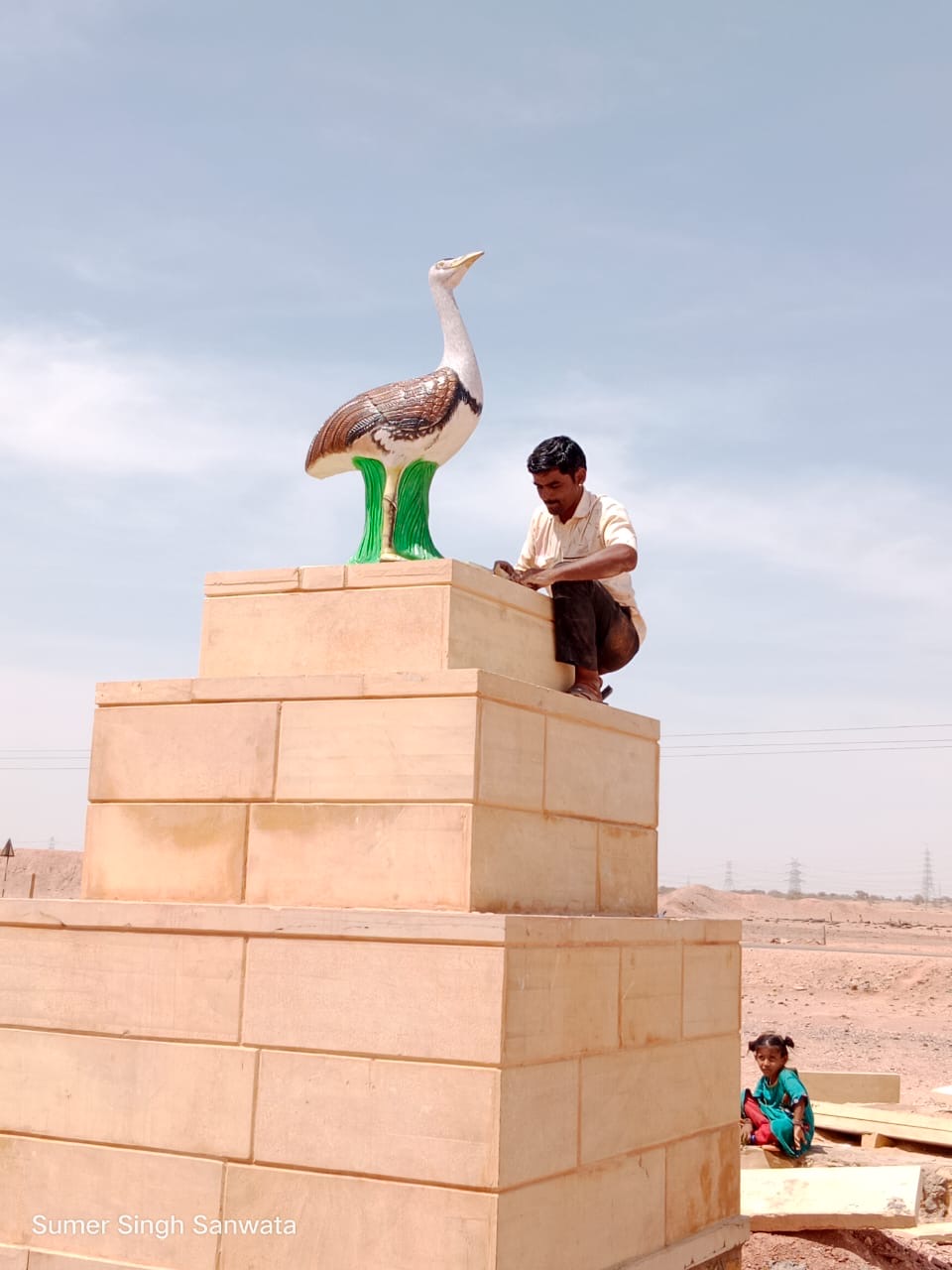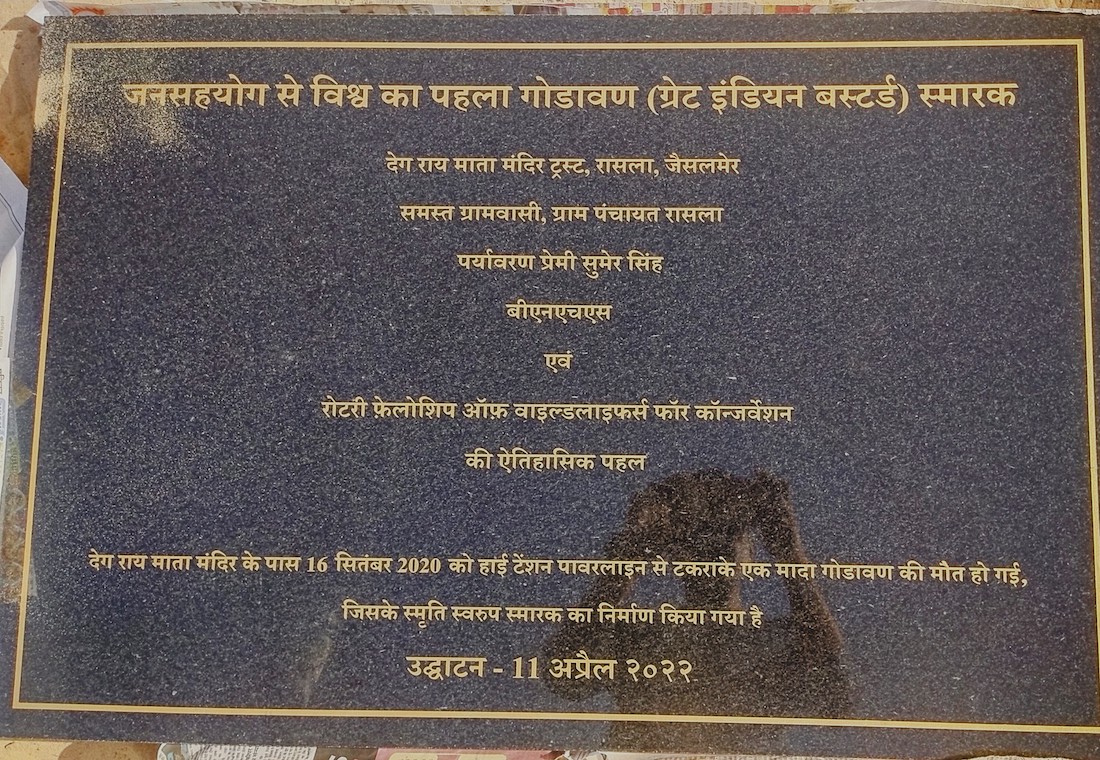The Great Indian Bustard (GIB), which used to thrive across the Indian subcontinent, now faces severe challenges due to habitat loss, degradation, and fragmentation stemming from the relentless increase in anthropogenic disturbance across its range. The population of this critically endangered species (Ardeotis nigriceps) is now primarily confined to the Thar Desert in Rajasthan, India. However, here, too, the species survives in low numbers in pockets of fragmented grassland habitat where a viable breeding community is often lacking. Thus, the bird’s long-term survival is at stake. However, not all hope is lost, and the recent initiatives taken to protect the bird by the local community members residing near the Oran of the Shree Deg Rai Mata Temple in Rajasthan’s Jaisalmer District are truly praise-worthy. Led by Sumer Sing Bhati, a local resident and pastoralist, a statue of a GIB killed by a power line collision has been erected in the Oran, recognising the sad plight of the bird and raising awareness on the issue among the conservation stakeholders.
The Sacred Orans Of Rajasthan

This Deg Rai Mata Temple Oran is one of the last bastions of the Great Indian Bustard. It is a sacred communal land revered by locals and protected through worshipping the deity Deg Rai Mata. The land was generously donated to the temple by local rulers over 600 years ago, and since then, the community has adhered to traditional practices to preserve its ecological integrity. In such orans, the locals adhere to several restrictions to maintain the sanctity of the habitat. Here, a unique land ownership structure exists. The land is exclusively entrusted to a community trust, preventing outside enterprises from undertaking large-scale land use changes. The government has officially recognised the orans’ sacred and ecological significance, acknowledging their importance for wildlife conservation. However, establishing formal protections is hampered by extensive bureaucratic requirements, including discrepancies in land records that date back over six centuries. Recently, there has been progress, as the government has designated two areas within this context as legal orans, which had previously existed only as informal community recognitions.
Protecting The GIB’s In The Deg Rai Mata Oran

Despite the adoption of protective measures, significant threats have emerged in the Deg Rai Mata Oran in recent times. The installation of powerline poles occurred without comprehensive impact assessments in the Oran. This oversight led community members to believe that they would result in negligible harm. In reality, however, the structures have become a serious collision risk for the Great Indian Bustard and other avian species.

The first scientifically documented collision involving a Great Indian Bustard occurred in September 2020, during the birds’ typical migratory movements into the Oran. This tragic event was brought to light by resident Shri Sumer Singh Bhati, who observed the growing threats posed by the expanding network of powerlines in the area. His efforts were critical, especially considering that younger generations are increasingly becoming unfamiliar with the bustard’s existence, jeopardising awareness and conservation efforts.

In response to this crisis, Sumer Singh launched a community-driven campaign to honour the bustard that passed away in 2020 and raise awareness about its plight. His initiative included creating a statue commemorating the bird and its significance in the local ecosystem. Through diligent fundraising efforts, involving residents and outreach within the community, and coordinating with the BNHS to help cover project costs, Sumer Singh succeeded in facilitating the sculpting of this memorial.

The statue, now prominently displayed near the Deg Rai Mata Temple, has attracted many visitors and significantly enhanced community engagement with the bustard’s story. It has also sparked a newfound respect for and interest in the bird, leading to a notable increase in the reporting of birds found dead due to collisions or other threats. Local pastoralists, now called “Godawan Mitras” (Bustard Friends), use smartphones to document sightings and report carcasses to Sumer Singh. This practice has created a vital network for scientific documentation and conservation efforts.
Local Community And BNHS Collaborate To Build The Godawan Sculpture

Creating intricate marble sculptures, a material known for its hardness and the precision required for fine details, presents considerable challenges. To tackle this task, Suresh ji, a highly skilled artist from Kishangarh, was integral to the sculpture’s creation. He facilitated the project through a collaborative effort characterised by numerous photography sessions and site visits, allowing him to understand the community’s vision closely. His artistic expertise enhanced the sculpture’s aesthetic appeal and ensured that it authentically represented the significance of the bustard and its legacy.

Following the sculpture’s completion, Pankaj Bishnoi, the Community Engagement Officer at the BNHS, took the lead in painting and installing the statue in its designated memorial site. Transporting the sculpture posed another logistical challenge, handled by Dr. Neelkanth Bora, the Program Officer for the Great Indian Bustard Project at BNHS. He helped transfer the sculpture from Kishangarh to the Deg Rai Mata Oran, exercising utmost care to maintain this valuable artwork’s integrity during transport. His dedication to this initiative reflects the broader commitment within the community and conservation organisations to protect and preserve the Great Indian Bustard for generations to come.

While preparing for the inauguration event, we encountered a challenge: a shortage of funds to cover the final expenses—fortunately, Adv. Sanjay Krishna, a Rotary Club of Wildlife Fellows member based in Bengaluru, came to our aid. Within just two days, he successfully rallied support from fellow club members and generated a generous contribution. This swift action alleviated our financial concerns and showcased our dedication to supporting wildlife conservation efforts.

Finally, the inauguration event on 21 April 2022 was made more special by the presence of Kulwant Roy Sharma, the Border Security Force Commanding Officer (BSF). His attendance underscored the importance of this project and highlighted the collaborative efforts of various individuals and organisations in honouring wildlife and promoting conservation.

The event celebrated art, community, and the ongoing commitment to preserving our natural heritage.
Author: Dr Sujit Narwade serves as the Deputy Director, Bustard and Florican Program, at the Bombay Natural Society and leads the BNHS

